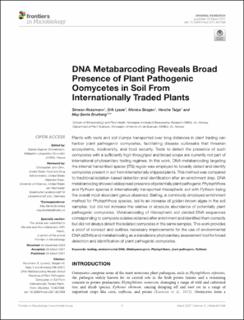DNA Metabarcoding Reveals Broad Presence of Plant Pathogenic Oomycetes in Soil From Internationally Traded Plants
Peer reviewed, Journal article
Published version
Permanent lenke
https://hdl.handle.net/11250/2762818Utgivelsesdato
2021Metadata
Vis full innførselSamlinger
Sammendrag
Plants with roots and soil clumps transported over long distances in plant trading can harbor plant pathogenic oomycetes, facilitating disease outbreaks that threaten ecosystems, biodiversity, and food security. Tools to detect the presence of such oomycetes with a sufficiently high throughput and broad scope are currently not part of international phytosanitary testing regimes. In this work, DNA metabarcoding targeting the internal transcribed spacer (ITS) region was employed to broadly detect and identify oomycetes present in soil from internationally shipped plants. This method was compared to traditional isolation-based detection and identification after an enrichment step. DNA metabarcoding showed widespread presence of potentially plant pathogenic Phytophthora and Pythium species in internationally transported rhizospheric soil with Pythium being the overall most abundant genus observed. Baiting, a commonly employed enrichment method for Phytophthora species, led to an increase of golden-brown algae in the soil samples, but did not increase the relative or absolute abundance of potentially plant pathogenic oomycetes. Metabarcoding of rhizospheric soil yielded DNA sequences corresponding to oomycete isolates obtained after enrichment and identified them correctly but did not always detect the isolated oomycetes in the same samples. This work provides a proof of concept and outlines necessary improvements for the use of environmental DNA (eDNA) and metabarcoding as a standalone phytosanitary assessment tool for broad detection and identification of plant pathogenic oomycetes.
